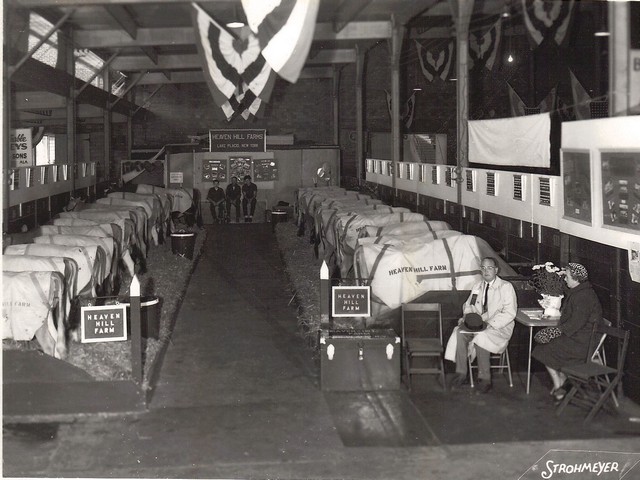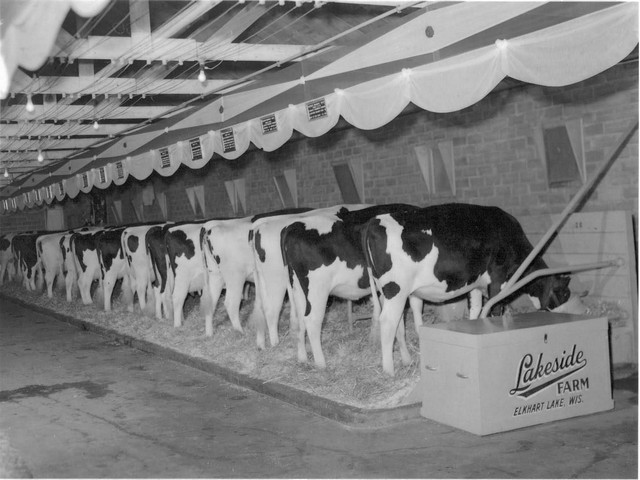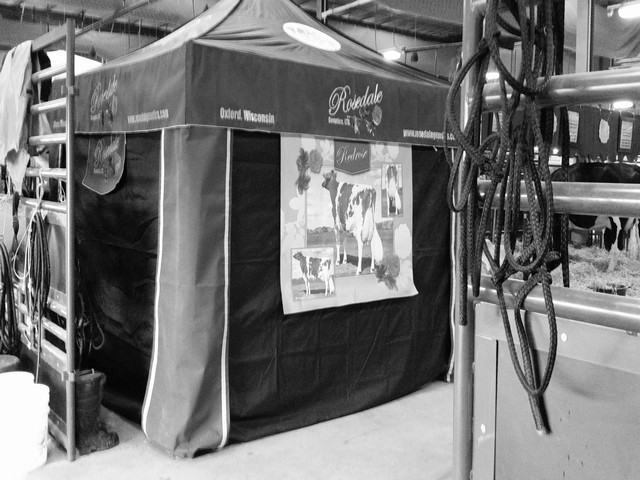At most exhibitions cattle are in the show-ring for less than an hour but can be on display for up to a week. For decades the purpose of showing has been a means of promotion of a product, be it the cattle themselves or a product the owner has, or of a service-like a sales management company. But for the most part showing is a way to display a breeding program. Some will argue, and certainly they have a point, that nowadays the act of showing cattle is a sport, no less and no more, and it is a valid argument.
In the 1930’s to 1950 Boulder Bridge Guernsey’s traveled throughout the U.S. displaying their show-herd, sometimes being on the road up to three months at a time. Their cattle were always meticulously presented with sometimes elaborate displays. Such an envy of other exhibitors, their herdsman Olaf Kjome was awarded the very first Klussendorf award. Then, as is now, showing was expensive and the
owner – the Dayton family was always cost conscious. This family was so astute in the business world that their Dayton Department stores became the forerunner of the Target store chain as we know it today. So showing had to stand on it’s own merits for the most part. At the start of the show circuit several bull calves were loaded on the boxcars and the plan was that by the end of the tour most of them would be sold, of course the huge premium checks would also fund the travel. Top shelf
advertising for a top shelf herd of Guernsey’s.

The 1940’s saw the Maytag herd of Holsteins traveling throughout the U.S. and an occasional trip to Canada as well. Like the Dayton family of Boulder Bridge, Fred Maytag was a businessman. His Maytag washing machine company was the leader in manufacturing the device and he branched out to just about every other form of housewares imaginable. Showing cattle was a means to promote not only his
great herd of Holsteins but also to promote his manufacturing business and his fledgling Blue Cheese company still in business to this day. Maytag Holsteins were a prized commodity wherever they were sold either privately or at auction.

If you count the signs above the cattle the number will be around 36 (+ or -) on this beautiful display of Jerseys owned by Mr. and Mrs. Henry Uihlein of Lake Placid, New York. Mr. Uihlein was a majority owner of the Joseph Schlitz brewing company but he had a passion for breeding and exhibiting Jersey cattle. On the right side of the display would be several purchased cows and on the left side would be all homebred heifers and bulls. The bulls could be yours for a price and there were more where they came from, the products of those beautiful cows. The most interesting part of this group is the amount of help to have it “picture perfect” upon Mr. and Mrs. Uihlein’s arrival around 8:00 a.m. The total workforce was four men to milk (by hand) three times a day, to brush and groom each and every animal three times a day, and to feed, water (no water bowls), clean and maintain the entire group and HAVE IT ALL DONE by 8:00 a.m. Military style precision at it’s finest.

During the 1950’s through the 1960’s two good friends from Wisconsin would set up beautiful displays of their cattle throughout the Mid-West. Ray Brubacher of Lakeside Farm and Allen Hetts of Crescent Beauty Farms. Lakeside was a well-funded herd, while Crescent Beauty was “Farmer Owned” and Farmer Financed”, but similar in the beautiful way they exhibited their cattle.

Mayfield Farm from Athens, Tennessee, used this group to promote their herd sire M.F. Lindale Beacon Bas and to sell semen and offspring from him. The show cattle on display in the South helped in promoting Mayfield Milk and Ice Cream to housewives in their part of the Country.
Times have changed and now promotion is as easy as turning on a computer but yet many still believe that showing cattle can be used for promotion as well as for sport.
MD-Hillbrook’s beautiful string of cattle is used to promote a sales company and auctioneer service. The show herd is a mixture of MD-Hillbrook’s and their clients. As their name implies, “Sales” is the premise for the display. All animals are either for sale or have been sold and if they don’t have what you want on display they will certainly find it for you.

Kueffner Holsteins and Jerseys have been prominent on the grandest of stages and their displays of their show herd ranks with the best. Cow comfort and organization are the key words they use. Cattle are displayed in a well-orchestrated manner with extreme emphasis on attention to detail. The goal of promoting their cattle has resulted with not only a basketful of banners and trophies, but also several high dollars sales of animals through the last twenty years.
Rosedale Genetics is not only the home of some of the world’s finest cattle, but the two owners, Mark and Nicky Rueth, are the only Husband and Wife team to be awarded the coveted Klussendorf/McKenzie award. This award was named after Duncan McKenzie who was considered the ultimate herdsman of his day and his displays of cattle were the envy of his peers. His attention to cleanliness and cattle care were second to none and award winners are sought to be in his image.
Rosedale’s goal is to promote a unique breeding program with emphasis on strong maternal lines and longevity. Their goal of promotion has paid off with two very successful herd sales in the last eight years.

Although some of these herds were funded by well-financed owners, most of the groups are farmer/breeder/promoter strings of cattle. Here are some similarities that they have:
The following are some guidelines to having one of these eye appealing strings:
ORGANIZATION: make sure your exhibit is organized, which can and should start a long time before you load your trailer.
CLEANLINESS: Soap and water! Have not only your cattle clean but the people looking after them as well. Soap is cheap! Not only should you pack a broom, but use it. Make it a clean environment for potential clients to observe what you have on display. Brooms are cheap.
PAINT: Clean up your tools, as in forks, brooms and shovels, etc. and have your farm colors painted. The equipment does not have to be new but it can look new with some cleaning and a coating of fresh paint.
Make sure your cattle are comfortable, clean and well attended at all times, not just show day. You are selling to the public whether you are selling genetics or yourself and the public as a whole likes clean. Yes you want to win, but for the most part the judge won’t be a buyer, the people that walk through the barns will be.
Only take the amount of cattle that your crew can take care of efficiently and effectively. To do it correctly takes a lot of work, make no mistake about it. The Heaven Hill herd of near forty head only had four men doing the work, but they did work. The beautiful Lakeside group included Ray Brubacher and one, that’s correct, ONE other man. The Allen Hetts group was Hetts and one other man. Amazing as it
is, these gentlemen still had time at night to do a little socializing with their peers.
Keeping your display simple and clean does not cost a bunch of money but it will take a lot of work before, during, and after the show. If you look at these pictures you will not see those lawn chairs with the drink holders anywhere to be seen. Save them for relaxing when you are at a lawn party.
As you prepare for your trip to the county show, state fair, regional show, Madison or the Royal, remember this “sport” can be rewarding in many ways, but like all “sports” those that achieve the most work the hardest.
